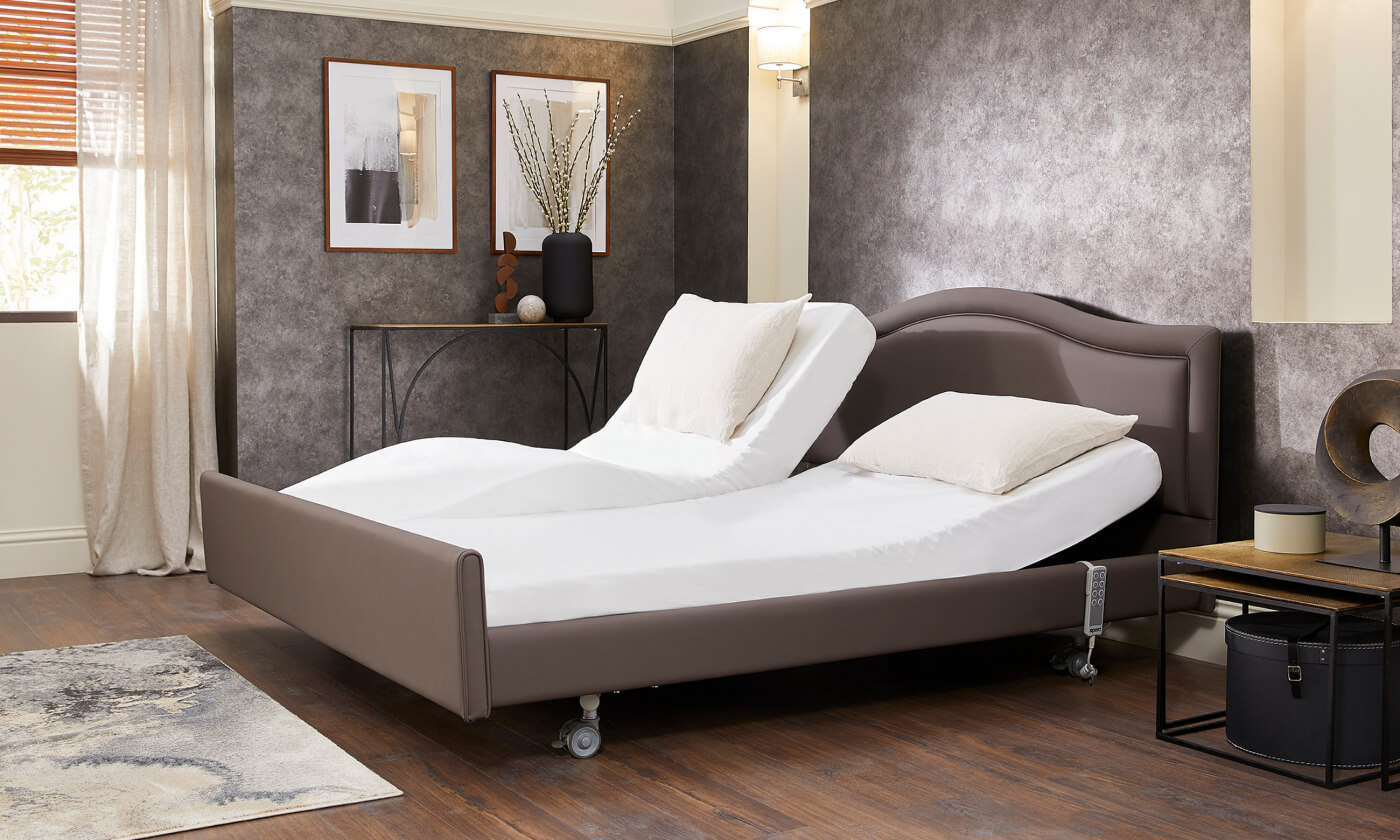Adjustable Beds Vs Regular Beds
Social Links
When was the last time you had a really good night’s sleep? The kind that leaves you feeling refreshed, restored, and full of energy for the day ahead? If you can’t remember, it might be time to have a look at your sleeping environment. After all, when you consider that good sleep can have a huge impact on our quality of life, doesn’t it make sense that we should do everything we can to ensure we’re getting enough?
One of the best ways to immediately improve our sleep is to invest in a good quality bed and mattress. Being supported in the most comfortable position for you can make the difference between waking up stiff and sore, or bouncing out of bed with a spring in your step, ready to enjoy the day. But where do you start when there are so many options to choose from? Can the right bed really stave off the effects of ageing? And how do you choose the right bed, if you don’t know what your future health needs will be?
- How is an Adjustable Bed Different from a Regular Bed?
- Is an Adjustable Bed Better than a Regular Bed?
- Can Adjustable Beds Really Improve Sleep Quality?
- Who Can Benefit from an Adjustable Bed?
- Are Adjustable Beds Worth the Investment?
How is an Adjustable Bed Different from a Regular Bed?
An adjustable bed, as the name suggests, is a bed that can be moved into different positions via hinges called pivot points. The simplest adjustable beds have one pivot point, at the hips, which allows the user to sleep with the head slightly raised, or sit up in bed entirely. A higher-care model may have up to four pivot points, for raising the knees, lifting the lower legs and supporting the head.
Combined with a supportive adjustable mattress such as memory foam, this adjustable positioning provides much more support than cushions alone. Tailored measuring ensures that the hinges are placed in the correct positions at the knees, hips and neck, so your body is supported in just the right position. This means you’re much less likely to toss and turn or wake up due to discomfort.
Is an Adjustable Bed Better than a Regular Bed?
While it’s true that a good quality, regular bed with a well-made, supportive mattress can still be comfortable and result in a good night’s sleep, adjustable beds give you more chance of finding your ideal sleep position. So even if you don’t have any current health needs, it’s worth considering whether or not that extra positioning might serve you better in the future. To help you decide, there are a number of advantages of each to consider:
Advantages of an Adjustable Bed:
- Adjustable beds are easier to get in and out of, which promotes mobility, prolongs independence and preserves dignity.
- They are available as double or single beds.
- Double beds come with dual motor function, so each partner can adjust their side independently of the other.
- Raising the head can greatly increase the quality of your sleep.
- Adjustable beds are designed to look like regular beds, so won’t look out of place in a home setting.
Advantages of a Regular Bed:
- Due to the absence of moving parts and motors, regular beds are lighter and easier to move than adjustable beds.
- They don’t need to be near a power source.
- You can use a regular bed with any mattress.
- Regular beds tend to be more budget-friendly than adjustable beds.
Can Adjustable Beds Really Improve Sleep Quality?
In a word, yes. Experts say that raising the head even as much as can have an enormous impact on our sleep, because it prevents the tongue from slipping back and makes breathing so much easier. This freeing up of the airways has been shown to ease the symptoms of several sleep-related breathing conditions including, sleep apnoea and snoring, while the counter-effects of gravity on the digestive tract minimises nighttime interference from indigestion by keeping stomach acids down where they should be.
Sleeping in this supportive position can also significantly reduce the aches and pains that may wake us up during the night. For example, the zero gravity position (when the head and knees are slightly raised), supports the spine in its natural ‘S’ shape, which takes pressure off the lower back and can greatly ease the symptoms of back pain and sciatica – it can even help improve our posture during the day. These combined effects mean we are less likely to wake up during the night, so we achieve more uninterrupted, good quality sleep, further enhancing the above advantages.
Who Can Benefit from an Adjustable Bed?
Almost anyone can benefit from sleeping in an adjustable bed, but for some people with specific issues or illnesses the ability to get a decent night’s sleep could be life changing. Those who will gain the most advantage from sleeping on an adjustable bed include:
Long-term bed users – such as older people with limited mobility, or anyone going through a temporary convalescence, such as in recovery from surgery, illness or injury.
Arthritis sufferers – arthritis can make an enormous difference to achy bones and joints, which often feel much worse at night.
Disgruntled partners – if your nights are plagued with incessant rumbling from the other side of the bed, then having your partner sleep with their head slightly raised could make a big difference to you, too! Plus most adjustable double beds come with a dual motor function, which means you can stay flat if you prefer.
People with circulation issues – sleeping with the legs slightly raised has been shown to significantly reduce problems associated with .
Anyone who likes to sit up in bed – if you often take breakfast in bed, or finish your evenings sitting up with a good book, the extra support from a raised mattress will make this much more comfortable and reduce the need for constant pillow adjusting.
Side and back sleepers – it can take a bit of time to adjust to sleeping in a new position, but once your body gets used to it, side and back sleepers should have no trouble. On the other hand, the raised position is not recommended for front sleepers, as it can restrict your airways and force your spine into unnatural positions, so you’ll wake up feeling stiff and sore.
Are Adjustable Beds Worth the Investment?
You may think that adjustable beds are just for the elderly – perhaps they even conjure an image of a sterile hospital environment lacking any sort of charm – but that isn’t the case. For a start, the Mobility Furniture Company’s range of adjustable beds is specifically designed to fit into a home setting, with all the parts and components hidden and upholstery tailored to suit any bedroom décor. And don’t forget you can always personalise the look with bedding, throws and cushions.
Consider too that several health conditions that can be eased with an adjustable bed don’t just affect the elderly – almost two in three UK adults will experience lower back pain at some point in their lives, and it’s estimated that over five million of us are now living with diabetes. The average age for the onset of sleep apnoea is 62 years old, while arthritis is known to start developing as early as the mid-40s. With all that in mind, it makes sense to consider that our needs may change as we age, and as a good quality adjustable bed can last for many years, it may be worth the investment even if we don’t feel the need for it just yet.
The Bottom Line
Everything feels better when we’ve had a good night’s sleep – so what we sleep on (and in) should be high on the list of considerations for maintaining quality of life in our golden years. It can take time to adjust to a new bed, but once we find our perfect position, we feel the benefits not just at night, but in our waking lives, too.
To be sure you get the right one, try a few out in store, or better yet get the team from the Mobility Furniture Company to come and give you a demonstration in your home. After all, enough issues can disturb our sleep as we get older – and lumpy, squeaky or unsupportive beds shouldn’t be one of them.
*This website contains general medical information. The medical information is not advice and should not be treated as such. Read our full Medical Disclaimer here.



